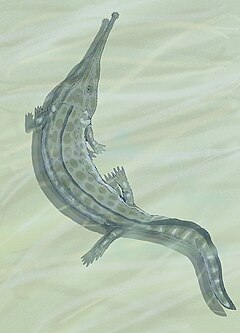Prionosuchus
|
Prionosuchus Temporal range: Guadalupian, 270 Ma |
|
|---|---|
 |
|
| Life restoration | |
| Scientific classification | |
| Kingdom: | Animalia |
| Phylum: | Chordata |
| Order: | †Temnospondyli |
| Family: | †Archegosauridae |
| Subfamily: | †Platyoposaurinae |
| Genus: |
†Prionosuchus L. I. Price, 1948 |
| Species: | †P. plummeri |
| Binomial name | |
|
Prionosuchus plummeri Price, 1948 |
|
Prionosuchus is an extinct genus of large temnospondyl. A single species, P. plummeri, is recognized from the middle Permian period (270 million years ago). Its fossils have been found in what is now northeastern Brazil.
The fragmentary remains of this animal have been found in the Pedra do Fogo Formation in the Parnaiba Basin of Northeastern Brazil, and it was described by L.I. Price in 1948. The incomplete skull of the holotype specimen has been estimated to be 50 centimetres (20 in) long. Several more fragmentary specimens have been found. One very fragmentary but very large specimen (BMNH R12005) appears to have come from an individual nearly three times the size of most other specimens, and may have had a skull that measured up to 1.6 metres (5.2 ft) long. Based on related species, the total body length of this specimen has been estimated at about 9 metres (30 ft), making it the largest known species of temnospondyl.
With an elongated and tapered snout, numerous sharp teeth, long body, short legs, and a tail adapted for swimming, its general appearance was very similar to a modern crocodile, particularly to the gharial, and it probably had a similar lifestyle as an ambush aquatic predator feeding on fish and other aquatic animals.
Prionosuchus has been classified as an archegosaurian by Carroll. The genus is monotypic with P. plummeri being the only species described. The archegosaurs were a group of temnospondyli that occupied the ecological niche of crocodiles and alligators during the Permian, and of which the European genus Archegosaurus is typical. The group became extinct at the end of the Permian and the niche was subsequently filled by other, new temnospondyls, later joined by reptiles such as the phytosaurs in the Triassic period.
Cox and Hutchinson re-evaluated Prionosuchus in 1991 and synonymized it with the genus Platyoposaurus from Russia. On the basis of this study, the Pedra do Fogo Formation was reevaluated to be of Middle to Late Permian age. However, studies based on plants and pollens indicate that this formation is actually early Permian in age, making Prionosuchus not contemporary with Platyoposaurus.
...
Wikipedia
